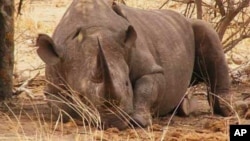From VOA Learning English, welcome to As It Is. I’m Steve Ember
Today we tell about how the United States is trying to help control poaching in Africa.
And, we take note of a very special phonograph record called “Sounds of Earth” that was launched into space on this date in 1977. We’re still waiting for a reply.
The United States recently launched a 10-million-dollar effort to help fight animal poaching in Africa. Money from the illegal trade in animal products may be supporting some militant groups on the continent. But at least one expert says the American effort alone will not be enough to solve the problem.
Johan Bergenas is with the Managing Across Boundaries Initiative at the Stimson Center, a non-profit group in Washington. He says current anti-poaching efforts have failed to stop the killing of thousands of animals every year.
He says poaching across borders is not new as a criminal activity. He notes that the killing of animals has increased over the past 12 to 18 months. And cross-border criminal groups and terrorist organizations are involved.
Johan Bergenas says Somali militants, for example, have gained from poaching. He says that for a number of years, the Kenya Wildlife Service has reported a strong link between the militants and al Shabab. American officials have shown ties between the Somali-based group and Al-Qaeda.
“The more interesting and dangerous pattern, though, is that transnational criminal groups are now increasingly profiting off of poaching and adjacent activities.”
Mr. Bergenas notes reports from witnesses who had left the groups. Some said the Lord’s Resistance Army is targeting poaching and the profits from that activity to buy supplies, arms and other equipment.
The expert adds that criminals are trafficking other goods in addition to animals and animal parts. They include drugs, weapons and cigarettes.
Mr. Bergenas says more game park rangers and others are needed to protect African wildlife. So is more and better equipment. He compared the technology used by criminals with what is available to crime-fighters.
“These poachers are no longer using non-sophisticated weapons. They are really going after the use of helicopters, machine guns, vision goggles (so) that they can see at night. And we have to respond with the technology that the ’good guys’ have in managing these issues.”
The Stimson Center official says recent action taken by the Obama Administration is a big step in the right direction. The World Wildlife Foundation and the African Wildlife Foundation have also praised the effort.
President Obama recently declared an executive order to fight wildlife trafficking. African countries will receive 10-million dollars in aid to help toward that goal.
The order calls for a presidential task force to develop and enact a plan to support efforts against illegal wildlife trade within six months. The plan would help with the organization of area law enforcement and stop the illegal trade of products. It also would attempt to reduce the demand for illegally traded animal parts.
But Mr. Bergenas says that, welcome as it is, the 10-million dollars from the United States is not enough to solve the wildlife trafficking problem.
He says America and its European allies need to take a different approach when they become partners with African nations against illegal trafficking. The goal would be to be more effective in dealing with their special problems, whether they are poaching or international terrorism.
The Stimson Center official says use of drone aircraft – might be one way to deal with poachers. He said such aircraft carry cameras -- not weapons. He said the airplanes might answer some important questions.
“When the poachers are sent into these game parks to kill the rhino or the elephants – and to take their tusks and their horns – how did they get there? How are they able to get around police, wildlife services and other counter-poaching efforts?...”
Mr. Bergeras also said African animals can be saved by reducing the demand for animal parts in Asia.
You are listening to As It Is from VOA Learning English. I’m Steve Ember.
Remembering "Sounds of Earth" - Will They Answer?
Scientists and philosophers have long wondered: Is there life on other planets? In other solar systems? And if there is, as many believe, what might extraterrestrial beings think of…us?
It was on this date in 1977, that the American space agency sent a phonograph record about life on Earth into space. It was carried aloft in an unmanned spacecraft called Voyager II. Space agency officials hoped that these “Sounds of Earth” might possibly find their way to life on other planets.
Scientist Carl Sagan and his team decided what to include on the record. Many experts praised “Sounds of Earth” and the idea of attempting to communicate with other life forms. The record was made on a disc of gold-plated copper. It measured about 30 centimeters across. It came with a phono cartridge and stylus, or needle, and pictures showing how to play it.
It contained information about human beings and science, and provided sounds like thunder, wind and rain, and calls of earthly creatures like birds and dogs.
There were spoken greetings in 55 languages. World leaders including Jimmy Carter, then president of the United States, sent messages.
And there was music of many kinds, including both Eastern and Western classical music…and Chuck berry singing about an earthling named Johnny B Goode.
Another copy of “Sounds of Earth” was placed on Voyager I. That unmanned spacecraft was launched two weeks after Voyager II. Both spacecraft explored the outer solar system and sent back to Earth information and pictures of faraway planets.
But, so far, we’ve had no response to this recorded sampling of Earth culture. But, as the English expression goes, the night is young…and who knows? Perhaps we’ll still get an answer…from somewhere in the distant, infinite reaches of a galaxy far, far, away.
Earthling Steve Ember here, inviting you to join us next time for another As It Is, from VOA Learning English.
[Sounds from the film “Close Encounters of the Third Kind]






